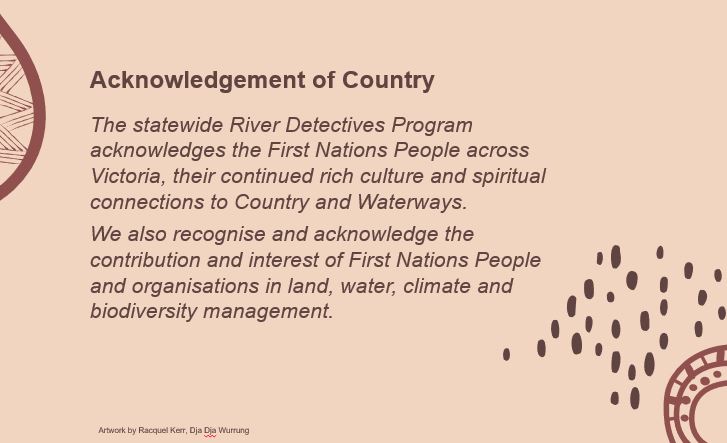Video/Audio
Delving Into The Data webinar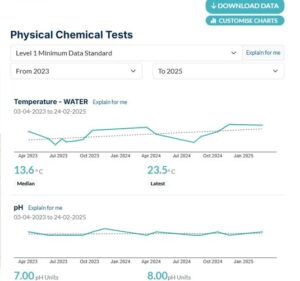
Explore the River Detectives website and WaterWatch data portal with statewide WaterWatch facilitator Justine Holmes to learn how to retrieve, interpret, compare and share the waterway data you collect along with data collected by the network of River Detectives schools and WaterWatch volunteers across the state.
|
Students create an early flood warning system for their town
Young St Joseph’s PS students from Eugowra NSW have developed an early flood warning system for Eugowra after unprecedented floods devastated their town in 2022. They presented their project to expert adults from around the country at the Floodplain Management Australia national conference in Melbourne in May 2025. Their inspiring video is such as great example of student-led inquiry-based practical learning, community collaboration and advocacy, innovation to create an early flood warning system and a powerful way for these students to alleviate some of the trauma they lived through.
|
Wandiligong PS River Detectives Story
Wandilogong has successfully embedded River Detectives activity into the curriculum through their Sustainable Wandi program where learning about waterways complements food production, waste reduction initiatives and habitat creation. Watch the video to hear the highlights or read the full story here.
|
Video stories showcasing River Detective participants
The River Detectives program can be adapted to suit the needs of participating groups. You can find written and video stories here to ishowcase the variety of ways that participants have embedded the program into curriculum, leveraged off the program to achieve broader sustainability goals or completed innovative projects; Bridgewater PS, Stawell PS, Dean’s Marsh PS, Victory Christian College, Covenant College, Minyip and Rupanyup Kindergartens, and Wandiligong PS.
|
Minyip and Rupanyup Kinders River Detectives Story
The program does not routinely deliver incursions to early childhood settings but in 2024 there was an opportunity for this to happen in the Wimmera CMA region. This story is a lovely showcase of the curiosity, passion and learning that can be ignited in our very young people by the smallest of creatures that live in our waterways. Watch the video to see the highlights or read their full story here.
|
Covenant College working with Landcare Story
Covenant College has worked closely with Batesford Fyansford Stonehaven Landcare for over a decade. For the past four years, the River Detectives program has value-added to their partnership. Their story is a great example of the benefits of strong collaboration with community groups. Watch the video to see the highlights or read their full story here.
|
Victory Christian College River Detectives Story
Victory Christian College is a large P-12 school in the North Central CMA region implementing the River Detectives program to boost their Environmental Science subject area and offer it as a VCE pathway subject to Years 9 and 10 students. Watch the video to hear their inspiring highlights or read the full story here !
|
Sustainable Farms – enhancing dams resources
Dams are well-known features of farming landscapes. They are also valuable natural assets. ANU’s Sustainable Farms project works with farmers, land managers, NRM agencies, industry groups and Landcare towards a common goal: healthy farms, healthy farmers and healthy profits. They offer a range of great resources: a farm dam poster, life in a farm dam activity sheet, the Enhancing Farm Dams guide and the farm dam planting guide. For some great videos watch: Improving farm dams – a farmer’s perspective, life in a farm dam – after fire comes recovery and building a wildlife island on a farm dam. If constructing or renovating a dam, for the farm dams technical guide click here.
|
Kayaking down Bendigo Creek
Unplug and Play was an innovative North Central CMA project created to encourage Gen Z’s to disconnect from technology and connect with the environment. The five-part documentary showcases the epic Bendigo Creek in all its forms and the natural environment that surrounds it. Kai and Jessie face all sorts of challenges along the way as drones and go-pros capture their honest reactions to the good, bad and interesting of this often-misunderstood waterway. The videos are a unique way to raise awareness of Bendigo Creek (especially beyond the urban fringe) and inspire your own students to have their own learning adventures in nature.
|
Soil: Nature is Speaking video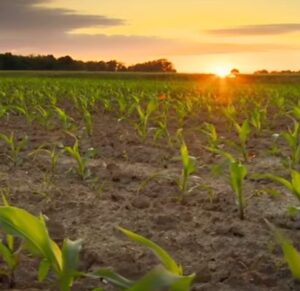
This short video is a thought-provoking resource to start conversations and learning about soils, the important role they play and to prompt investigation into how we can care for soils better.
|
Getting the Buzz on Bees and other beneficial insects video
There is a huge variety of beneficial insects in our gardens. They help us pollinate, break down soil, and balance the local ecosystem. In this Junior Landcare video Costa shares his experiences with these special insects in his own garden.
|
Dramatising La Nina and El Nino climate patterns
Bridgewater PS requested a River Detectives incursion to help their students understand the factors that had contributed to the significant flooding their town experienced in October 2022. Coordinator Nicole involved the students in this dramatisation to understand La Nina and El Nino.
|
Blackwater pros and cons video
At the right time of year, good blackwater is nature’s gum-leaf tea and is huge boost for our rivers, creeks and fish. In the wrong conditions, blackwater can be toxic. Learn more with this video. And to learn how environmental water releases can help minimise the impacts of blackwater watch this video.
|
From River Detective students to WaterWatch volunteers video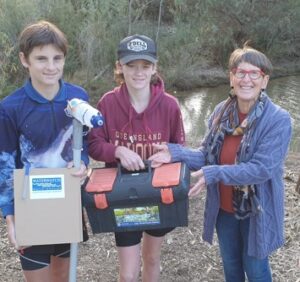
A lovely story about the pathway from the River Detectives program to WaterWatch volunteering, highlighting the importance of fostering care for nature in the next generation and the future opportunities for River Detectives students.
|
The way a creek starts to run video
We usually see our creeks and rivers with water in them but after a dry spell they start running again from inflows. Have you ever been on site to see it ? Watch this video and be entranced by the magic of nature!
|
Webinar: River Detectives and ResourceSmart Schools program crossovers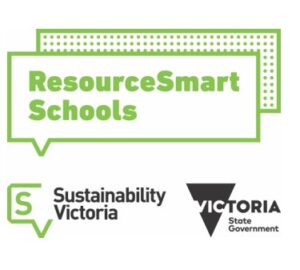
Learn about how the River Detectives program can help schools achieve water, biodiversity and waste RSS modules so the two programs can work smarter, not harder!
|
River Detectives achievements videos
Sit back and be proud of all that River Detectives achieves across the state by viewing the 2024 achievements video or past videos; 2024 mid-year achievements video , 2023 achievements video.
|
Coastcare Victoria Schools Kit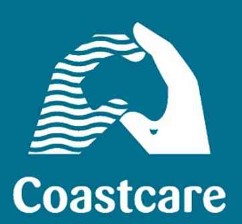
Coastcare Victoria has created a new education resource. The aim of the resource is to engage young people in caring for marine and coastal environments. The kit consists of a collection of video clips with simple, easy to follow lesson plans. Lesson plans include engaging activities including quizzes, games, videos, and investigation worksheets. The school kit is aimed for years 5-8. It is a flexible resource that is adaptable to younger or older audiences. To learn more about the Schools Kit watch this 45 minute webinar presented by Coastcare facilitators.
|
The pH scale explained
A great explanation of the pH scale, acidity and alkalinity in relation to everyday objects. Please note; alkaline substances are referred to as ‘bases’ in this video. The acidity and alkalinity of substances are related to taste in the video – be clear with students that they should NOT be tasting anything that is not food.
|
How one scientist took on the chemical industry – video
In 1958, after receiving a letter describing the deaths of songbirds due to the pesticide known as DDT, Rachel Carson began an investigation into the misuse of chemicals and their toll on nature. In 1962, she published her findings in “Silent Spring,” which immediately drew both applause and impassioned dissent. How did this biologist and writer ignite such controversy?
|
Pesticide-free farming; Using good bugs to fight bad bugs video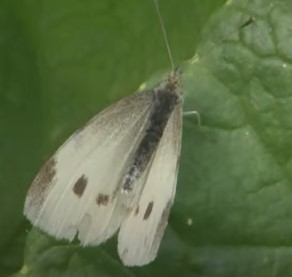
A segment from ABC’s Landline program about organic solutions to control pests at the large farm scale. For ideas to control pests using alternative methods at the home garden scale watch this segment from Gardening Australia or use this lesson plan from Junior Landcare.
|
Do we really need pesticides ? video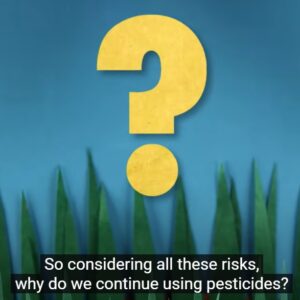
Pest control is a necessary part of farming and food production but can we do it without pesticides that can cause harm to waterways and catchments ? This video clearly examines the pros and cons of pesticide use.
|
Native Fish Recovery Plan – working with landholders video
The Native Fish Recovery Plan aims to improve flows, connectivity and habitat to bring back our native fish in healthy numbers. Tim Sawers of Sawers Farms talks about the benefit to his properties of working with the Native Fish Recovery Plan and creating habitat for threatened and endangered small-bodied fish.
|
What is environmental DNA (eDNA) ? video
This short video explains how eDNA can help us detect native and invasive species by providing evidence about what is or isn’t present in the environment – it’s like nature’s genetic fingerprint ! eDNA testing is innovative technology that enables the detection of species without having to see, hear or catch them. eDNA offers an unprecedented opportunity for monitoring endangered and invasive species, as well as for biodiversity assessments.
|
River Detectives data entry instructional video
Watch this video to help you enter your water quality data into the River Detectives data portal or use this illustrated guide.
|
Bendigo Creek restoration video
Clarence and Millie from Gardening Australia present a marvellous segment on Gardening Australia about the way Bendigo Creek is being reimagined, the way cultural knowledge is being embedded and the way we are looking to the future to bring back species and value this important urban waterway.
|
Frank Steele’s volunteer video story
To celebrate the Waterwatch Program’s 30th anniversary, Frank Steele shares why he has enjoyed volunteering as a water quality monitor for the past 11 years. His story highlights the value in monitoring intermittent waterways and collecting photos, even in dry times, as a way of tracking change over time and measuring climate change. To read the written story click here.
|
Kayaking the sickest urban river in Australia video
Join Beau Miles as he kayaks 23kms along Cooks River in Sydney over 4 days reflecting on it’s interesting past, it’s disturbing present and it’s hopeful future. An eye-opening journey about the plight of our littered urban waterways in modern society. ** Language warning ** Be aware some language will not be appropriate for younger viewers.
|
Saving the endangered Plains-wanderer bird
Critically endangered and at risk of imminent extinction, the North Central CMA is working in partnership with Trust for Nature and Australia’s National Recovery Team for the Plains-wanderer. Find out more about Plains-wanderers by viewing these videos about these quirky creatures; of using song meters to monitor populations, Werribee Zoo’s captive breeding program, incubating Plains-wanderer eggs and this gorgeous footage of the first captive-bred chicks. A picture storybook has now been released with teacher notes and is a great way to engage young learners. You can also use this beautiful colouring sheet. To learn more about the unique habitat of the Plains-wanderer check out the brochures ‘Plants and Vegetation of Native Grasslands on Victoria’s Northern Plains’ and ‘Wildlife of Native Grasslands on Victoria’s Northern Plains’.
|
The Magnificent Six video
Six small-bodied native fish species, specialists of the wetlands across the southern Murray Darling Basin, are on the brink of extinction. Learn about why and the things that are being done to save them in this video. This colouring sheet also features the magnificent six species.
|
Deans Marsh PS River Detectives Story
Deans Marsh PS is an active River Detectives school in the Corangamite CMA region embedding the program into the curriculum, into their school’s broader sustainability initiatives and connecting with their community. Watch the video to hear their highlights or read the full story here !
|
Stawell PS River Detectives Story
Stawell PS is a River Detectives school in the Wimmera CMA region exploring and testing waterways from local lakes to streams in Gariwerd (Grampians National Park). Watch the video to hear their highlights or read the full story here !
|
Bridgewater PS River Detectives Story
Bridgewater PS is a small school in the North Central CMA region achieving great things with their innovative Outdoor Classroom program where River Detectives takes a lead role. Watch the video to hear their inspiring highlights or read the full story here !
|
Trentham Golf Course benefits from A Healthy Coliban Catchment video
The Trentham Golf Club is keen to make a difference to their local environment, and the Healthy Coliban Catchment project is helping them achieve it. A great example of how waterways are integral to community life and we are all responsible for their health.
|
A Healthy Coliban Catchment project partnerships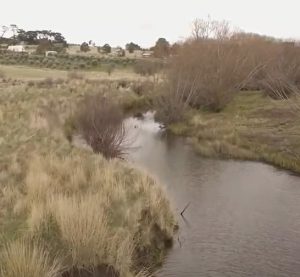
Hear about the collaboration between stakeholders to ensure A Healthy Coliban Catchment; landholders, landcare groups, traditional owners and organisations.
|
Landholders banding together for a healthier Coliban Catchment
A group of Drummond landholders are working together to help improve Kangaroo Creek, as part of the North Central CMA’s ‘A Healthy Coliban Catchment’ project. The project is working with locals to improve water quality and biodiversity of a catchment that provides drinking water for 130,000 people.
|
Reimagining Bendigo Creek Installation video
A short video montage from an art installation in the Bendigo Conservatory celebrating what Bendigo Creek habitat provides and what it could provide in future.
|
The Bendigo Creek Story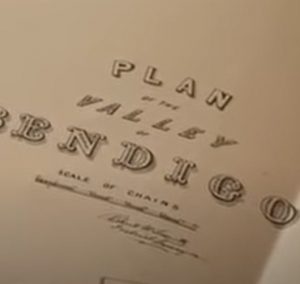
This film traces the history of the Bendigo creek to explore the savage environmental impact of mining on the local environment of the Bendigo goldfields. Features fascinating images of an 1852 unique hand-written and hand-painted map of central Victoria.
|
Taungurung Land and Waters Council and the Caring for Campaspe project
This is a great overview of the goals and benefits of the Caring For The Campaspe project, explaining to students how the NCCMA work alongside Traditional Owners and the actions they take to protect and enhance our waterways.
|
2022 Campaspe River Tour video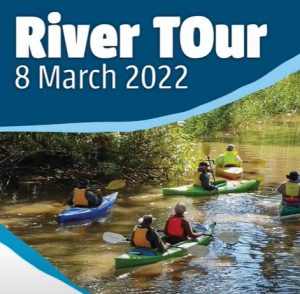
The Caring for the Campaspe project once again invited Traditional Owners together to spend time on Country to share, explore and learn from each other. Hear from participants about how valued this experience is.
|
River Detectives program claymation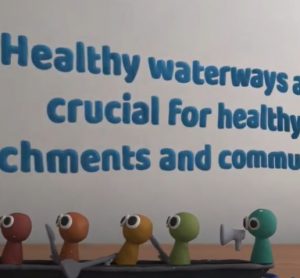
This claymation sums up what the River Detectives program is about and why we love it – great to share with colleagues, students, families, the wider community and to garner support for the program from local groups / businesses / funding bodies.
|
The Mysterious World of Eels video
This recording of an ARI seminar features Uncle Denis Rose and Dr Wayne Koster presenting on their partnership in eel migration research. It shares the importance of eels (both culturally and ecologically) and what we’ve learned through satellite tracking. The video runs for 1hr and is suitable for older viewers as a rare chance to dive deeper into the mysterious world of eels.
|
Manungaboomboom – Uncle Rick Nelson video
Uncle Rick Nelson’s story of Dja Dja Wurrung People and the impacts of colonisation on Dja Dja Wurrung County. Filmed in and around Leanganook, Mt Alexander region. This is a powerful and important story but please be aware there is some graphic content for younger viewers.
|
Wanyarram Dhelk, Bendigo Creek site tour video
Wanyarram Dhelk is a cultural expression encapsulating what Bendigo Creek once was, a series of waterholes that provided food and fibre resources as well as recreational opportunities for Djaara people. This important project demonstrates how integrating Traditional Owner knowledge with water sensitive design can help restore cultural, social and environmental values to a degraded urban creek and is a great example for students. Wanyarram Dhelk has provided an example for the whole community of the potential to ‘Reimagine Bendigo Creek’ and embrace its possibilities as a valued natural resource. Use this case study to learn more, visit the site with your students, talk with traditional owners about the project or do some of your own ‘reimagining’. The case study can be accessed here or view this great video about the City of Greater Bendigo’s new Reconciliation Plan.
|
‘Drought’ and ‘Flood’ picture story books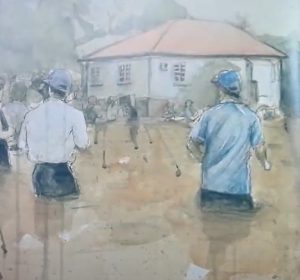
Two books by Jackie French highlighting the impact of Drought and Flood on landscapes, flora, fauna and people. Read the books or watch the online readings to start discussions about the way climate and natural processes sometimes seem irrelevant in everyday life but their impact on us are brought to the fore in times when nature is out of balance. Use the teachers notes for Drought and Flood to explore the two books with students.
|
Build Me A River video
John Gooderham is an aquatic and macroinvertebrate ecologist with a knack for sharing his enthusiasm for waterbugs. This video highlights the importance of in-stream and riparian zone habitat to healthy bug populations, takes us underwater into the secret world of waterbugs and provides incredible close-up video of waterbugs that you are unlikely to see elsewhere (including time lapse footage of a caddisfly emerging from it’s larvae form).
|
The impact of animal poo on our waterways
This article (and video) explains the impact animal poo has on our waterways and makes some interesting comparisons between the impact of native animal poo and exotic animal poo. The article is quite detailed but information can be extracted for younger students. The video is short and simple.
|
Barapa Water for Country video
A great video to showcase the importance and value in collaborating with Traditional Owners to understand, explore and heal country by embedding cultural knowledge, skills and aspirations in land management decisions. Follow the journey of the project; See here for a look at how the project began and for more information about its goal to work with the Barapa Cultural Team and identify, map and record the cultural values of the Lower Gunbower Forest to improve the management of environmental water. See here for the 2019 video.
|
The Riparian Revegetator video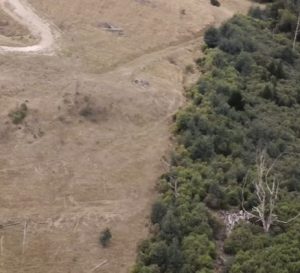
The riparian zone is the area between the land and a river or creek. Plants that thrive in this zone are known as riparian vegetation. The Riparian Revegetator tells the story of how, over the last three decades, Paul has transformed his land in Gippsland from a degraded and barren farm into a thriving environment, acting as a critical refuge for the local beasties. This is a great example of what landholders can achieve to enhance the health of waterways
|
River Moorabool movie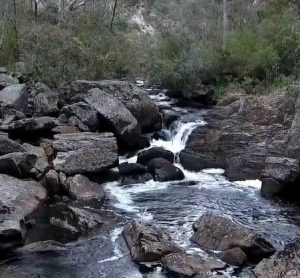
the River Moorabool was made by People for A Living Moorabool (PALM) and Sheoaks Films. It features local landowners, scientists, and healthy river advocates and explores the consequences of water demands on the Moorabool River, particularly in the face of climate change. At 48mins in length it is a compelling watch for senior students to promote deep discussions about water management issues.
|
Why do mass fish deaths occur ? videos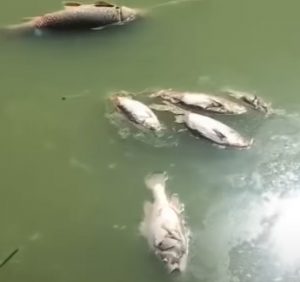
Between December 2018 and January 2019, three mass fish death events happened along a 40km stretch of the Lower Darling River, downstream of Menindee Lakes. Although this event occurred far from us in Victoria it was a highly public and very distressing event for everyone, seeing up to a million fish including 100-year-old Murray cod die in one of the biggest environmental catastrophes to hit the river. The video linked to the title above and this one here help students understand the issues around what happened. Note: views expressed are the opinion of the video producers not River Detectives or any participating CMA. And a warning that some scenes could be distressing for students.
|
Linking the Landscape – The Cobaw Biolink video
This video by Newham Landcare promotes the important role of the Cobaw Biolink in enhancing the connections between Mount Macedon and the Cobaw Range on both private and public land. Protecting existing high quality vegetation and creating connectivity in the biolink will help native plants and animals adapt to climate change. The video aims to engage the community and make them aware that their contribution, no matter how big or small, can have a positive impact on the environment on a landscape scale, making catchments and waterways healthier and everything that relies on them.
|
Intergenerational Trauma animation
In Australia, Intergenerational Trauma predominantly affects the children, grandchildren and future generations of the Stolen Generations. This is a confronting topic causing all Australians to reflect on our shared history. Care should be taken about how/when this content is presented but the video from the Healing Foundation is extremely well done and thought-provoking to stimulate conversations with older students.
|
The history of Mt Greenock
Time travel back 180 years to rarely visited places and events from the early contact period that marked the beginning of unimaginable loss and trauma for Dja Dja Wurrung people. Join Jaara Elder, Uncle Ricky Nelson and Professor Barry Golding as they stand together and reflect on top of the iconic volcanic slopes of Mount Greenock. This video teaches students a different way to look at their local landscape with fresh eyes and appreciate its history and significance to Aboriginal people. This is one of three videos in this series. You can also watch videos about the Loddon River at Neereman and Merin Merin wetland.
|
Traditional life at Merin Merin wetland
Join Jaara Elder, Uncle Ricky Nelson and Professor Barry Golding as they stand together on the top of the iconic volcanic slopes of Mount Greenock and explore the life-providing Merin Merin Wetland near Clunes where kangaroos still graze, highlighting the European and Aboriginal history of the site. This video teaches students a different way to look at their local landscape with fresh eyes and appreciate its history and significance to Aboriginal people. This is one of three videos in this series. You can also watch videos about the Loddon River at Neereman and Mt Greenock.
|
Loddon River at Neereman video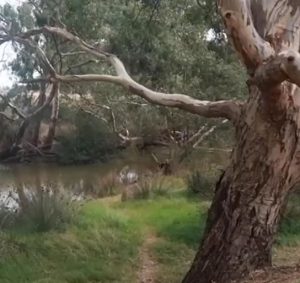
Time travel back 180 years to rarely visited places and events from the early contact period that marked the beginning of unimaginable loss and trauma for Dja Dja Wurrung people. Join Jaara Elder, Uncle Ricky Nelson and Professor Barry Golding as they stand together on the top of the iconic volcanic slopes of Mount Greenock to give a fascinating insight into the history of the Loddon River at Neereman near Baringhup and the early interactions between European and Aboriginal people. This video teaches students a different way to look at their local landscape with fresh eyes and appreciate its history and significance to Aboriginal people. A must watch if you’re studying the life and times of the Loddon River. This is one of three videos in this series. You can also watch videos about Merin Merin wetland and Mt Greenock.
|
Digital story; If We Care We Can: A Story of How One Glider Helped Save a Forest
‘If We Care We Can’ is a digital children’s story which is freely available online. It is reasonably long, 60 pages, but turn on the audio and it’s perfect to watch/listen to as a serial over several days. It is set in the forests of northern NSW but has many relevant messages for Victorian students. This story is best viewed on a tablet or computer in landscape view.
|
City of Greater Bendigo – Our Vision for Reconciliation video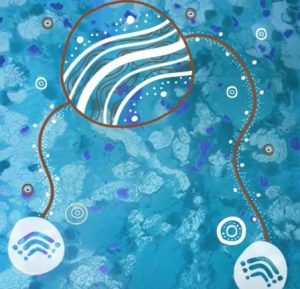
In November 2020, the City of Greater Bendigo launched its new Reconciliation Plan 2021-2025, Barpangu. Meaning ‘build together’ in Dja Dja Wurrung language, Barpangu was developed through conversations and consultation with the Dja Dja Wurrung and Taungurung Traditional Owners, the broader local Aboriginal and Torres Strait Islander community, and City staff. It builds on the success of their first Reconciliation Plan and aims to further advance reconciliation across the municipality. It is great example for students of how organisations can actively work on and promote reconciliation.
|
Earth Ovens – Celebrating Aboriginal Intangible Heritage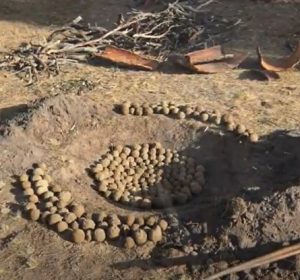
In November 2016, Barengi Gadjin Land Council, in partnership with Maurizio Campanelli, held Bakang Dyakata – a traditional Aboriginal earth oven recreation event. This annual event, held on the banks of the Wimmera River, brings the community together to cook using traditional techniques and taste native foods. It is an example of the rich intangible heritage of Aboriginal communities in Victoria.
|
Connection to Country: Leanganook (Mt Alexander Regional Park) video
Follow Ranger Trent, a proud Dja Dja Wurrung and Yorta Yorta man, through Leanganook/Mt Alexander Regional Park as he describes the importance of connecting to and caring for Country. A lovely video to see the landscape through a different lens for students in central Victoria.
|
Cultural Fire and Healing Yorta Yorta Country video
Listen to Yorta Yorta man Ralph Hume discuss cultural fire and healing country at the 2019 National Indigenous Fire Workshop near Dhungala (Murray River), Victoria, Yorta Yorta Woka (Yorta Yorta Country). A very interesting insight into how the landscape has changed since European settlement, why the riparian environment we see today is not considered healthy by traditional owners and how it can be healed.
|
Dja Dja Wurrung Tanderrum cultural ceremony video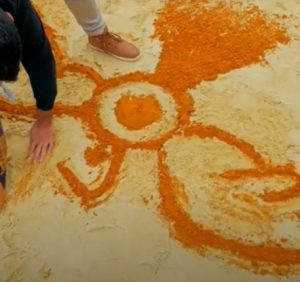
This is a powerful video put together when the Dja Dja Wurrung participated in the Melbourne Festival Opening in 2016 at Federation Square. Dja Dja Wurrung traditional owners joined five groups from the Kulin Nation in a tanderrum; a ceremony of welcome and hospitality for visitors to the land of the Kulin Nation. The video highlights the importance of cultural ceremonies to traditional owners, particularly now as a way of healing injustices of the past.
|
Nature Journalling activity
Be inspired by this video by central Victorian Trace Balla and start recording the things you see, hear, touch and smell at your local waterway or anywhere in nature. You can also access her Nature Journalling for Little Ones video or Nature Journalling for Teens video. Journal throughout a year and record the seasonal changes you observe. This ideas sheet from Paperbark Writer will help get you started too !
|
Brolga Bangarra Dance Theatre video
The brolga is a majestic bird of Victoria’s wetlands and has long been held as an important totem in traditional life. Watch a video of brolga’s visiting Tang Tang Swamp or a video about the birth of a brolga in central Victoria then enjoy watching the way the Bangarra Dance Theatre represents brolgas through dance.
|
The Water Tribe and Ochre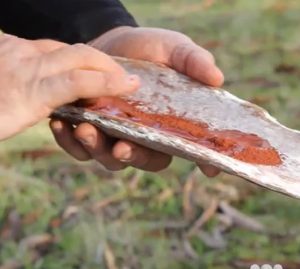
Proud Wathaurung man Barry Gilson is learning and writing songs in the language of his ancestors – a difficult task because “everything has been lost”. What does he mean by this? He also speaks of how ochre was and is used in Aboriginal ceremonies.
|
Soil Salinity in Australia video
This video was produced many years ago now but does a great job of explaining why increasing soil salinity in Australia is a serious land degradation issue. It outlines how all over the country, salt is rising out of the ground and destroying our farms, homes and towns. To understand why we have this problem, the video takes us back in time for a journey through Australia’s history.
|
How Does Desalination Work ? video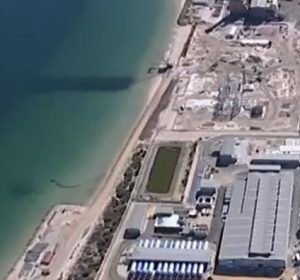
Perth’s water supplies are under pressure. The reason: declining rainfall in the southwest of Western Australia. Watch this video to tour a desalination plant and learn how sea water is turned into drinking water. With similar plants popping up around Australia, will desalination be the solution to our water shortages?
|
What Is A Catchment ? video
This very short video is a simple visual introduction to the concept of a catchment, suitable for all but perfect for younger students.
|
River Rehab: Protecting Waterways From Livestock video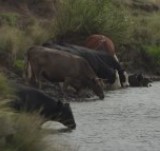
Watch this video to see how Tasmania’s farmers are taking measures to reduce degradation of the state’s waterways from livestock. This video introduces students to sustainable farming practices that protect waterways and increase farm productivity simultaneously. Draw your own farm plan and illustrate how it can be managed sustainably.
|
Where Does Water Go After It Rains ? video
What happens to rainfall in Australia? Water usually flows downhill, and because we know where the hills are, scientists have been able to divide the country into drainage divisions, or catchments. Watch this video to find out which drainage division you’re in, and learn what happens to rainwater that doesn’t make it to the sea.
|
Budj Bim eel trap system video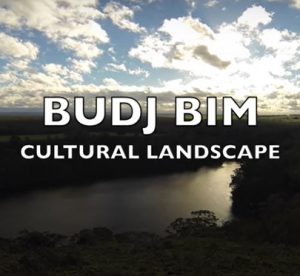
Budj Bim is a dormant volcano in South Western Victoria on Gunditjmara Country. Budj Bim means High Head in the language of Gunditjmara people and is home to one of oldest aquaculture systems in the world. Budj Bim is said to have erupted over 30,000 years ago and the lava flow that resulted created a system of channels that Gunditjmara people developed into weirs, dams and traps for fish and eels. Older students may wish to find out more about the UNESCO World Heritage-listed Budj Bim National Park by watching this 30 minute virtual tour presented by the Glenelg Hopkins CMA for the 2020 Victorian Nature Festival.
|
Virtual Electrofishing Tour video
Join Arthur Rylah Institute scientists for an electrified virtual field experience. Fishing with electricity (electrofishing) helps us learn more about fish, their habitat and how we can protect them. Arthur Rylah Institute work right around Victoria to surveys rivers, streams and creeks for all kinds of fish. This is one video in a series of incredible 360°perspective, virtual reality (VR) films. The films create virtual, first-hand experiences bringing science and the work of scientists to life. Although these films are best experienced using a VR headset, they are available online (viewing quality will vary depending on your internet connectivity). When viewing on your computer, use your mouse to hover over the video and look around or click on the arrows that are in the upper left-hand corner. Arrows will help guide you to key features of the video we don’t want you to miss, but remember, your time in the field is your own, and you can always revisit and explore other parts of the video. Visit here for other videos in the series.
|
Virtual Turtle Trapping in the Barmah-Millewa Forest video
Join DELWP scientists for an immersive field experience trapping for turtles in the Barmah-Millewa Forest on the Murray River. They’re monitoring the health of turtles to better understand how we can reverse the population decline of turtles in the area. This is one video in a series of incredible 360°perspective, virtual reality (VR) films. The films create virtual, first-hand experiences bringing science and the work of scientists to life. Although these films are best experienced using a VR headset, they are available online (viewing quality will vary depending on your internet connectivity). When viewing on your computer, use your mouse to hover over the video and look around or click on the arrows that are in the upper left-hand corner. Arrows will help guide you to key features of the video we don’t want you to miss, but remember, your time in the field is your own, and you can always revisit and explore other parts of the video. Visit here for other videos in the series.
|
The artistry and ingenuity of bird nests video
Whilst visiting your waterway each month for water quality testing you might notice the building and use of bird nests as a key seasonal change. Bird nests are endlessly fascinating and we can learn much about the skill, patience, resilience, artistry and ingenuity of birds by learning about the way they build and use nests. Although this is an American video it is a great resource to showcase the many different types of nests that birds build around the world. There are also some great picture story books about bird nests; Bird Builds A Nest by Martin Jenkins, Birds Build Nests by Yvonne Winer and Mama Built A Little Nest by Jennifer Ward. Watch this video of nest building up close or challenge students to gather materials and try building their own nest – it’s harder than they might think !
|
Platypus in Peril video
This video from our friends in the Upper Murray area explores the challenges platypus populations are facing and outlines the practical things that can be done to help. Features Geoff Williams from the Australian Platypus Conservancy.
|
Melbourne Water Platypus Program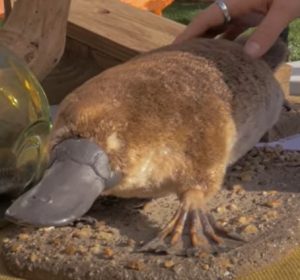
This short video provides some great information about the physical features of the unique platypus, their diet, habitat, threats, what is being done to help them and what we can all do to contribute.
|
Edithvale-Seaford Wetland video series
These six educational videos focus on the Edithvale-Seaford Wetlands in the Melbourne Water area, exploring their fauna and flora, rich history, role in providing drainage, and the community groups who play a key role in caring for them. Get a well-rounded understanding of the wetland’s many diverse roles, by watching the full video series: Animals of the wetland Birds of the wetland Drainage story of the wetland Friends of the wetlands History of the wetland Plants of the wetland
|
Animals of the Wetland video
Learn how wetlands support a variety of wildlife — including birds, reptiles, frogs, fish and bugs — which are all part of a complex food web. Filmed at the Edithvale-Seaford Wetlands in the Melbourne Water area the content is true for most wetlands. This is one of six educational wetlands videos featuring the Edithvale-Seaford Wetlands.
|
Surveying for platypus using eDNA video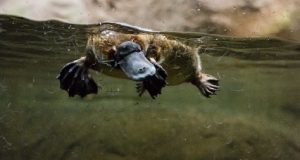
Environmental DNA (eDNA) is a non-invasive sampling technique that detects genetic material from a target species secreted into the surrounding environment (e.g. water). During 2020 the Upper Campaspe Landcare Network conducted the Platypus Project aimed to address the lack of contemporary knowledge about platypus and blackfish populations by investigating the current distribution of platypus and blackfish throughout the upper Campaspe area of the North Central CMA region using eDNA. Senior ecologist and platypus expert Dr Josh Griffiths from EnviroDNA led the project and provided the technical knowledge and advice to Citizen Scientists participating in this Project. Here he tells us all about it in a fascinating 14 minute video perfect for older students.
|
Why waterbirds don’t get soggy video
A great video from the Deep Look youtube channel looking at the waterproof qualities of feathers. Ducks and geese spend a lot of time preening their feathers. This obsessive grooming – and a little styling wax from a hidden spot on their back side – maintains the microscopic feather structure that keeps them warm and dry in chilly waters.
|
The Best Beak in Boonaroo Bay picture story book
This picture story book by Narelle Oliver is perfect for understanding how animals, in this case birds, have evolved over time to possess bodies that are just right for finding and eating their favourite foods. The birds in this watery environment all compete for the title of the ‘best beak’ but discover that they all have the best beak for their own needs. Use this book as a springboard to studying the adaptions of animals to survive – the ‘feathery friends’ activity is a small way to start with younger students.
|
Plants of the Wetland video
Learn why plants are important to a wetland, and how some were used by indigenous people for food, fibre and medicine. Filmed at the Edithvale-Seaford wetlands where there are 87 plant species with records of Aboriginal use, this is a great video for students in any region to understand the role wetland plants play. This is one of six educational wetlands videos featuring the Edithvale-Seaford Wetlands.
|
Frogs of the Wimmera slideshow
This very informative powerpoint presentation was put together by the Wimmera CMA as a PD for River Detectives educators in that region during 2020. It is full of information, graphics and useful links for teachers to brush up their own skills and arm themselves with content and resources to teach students about frogs.
|
How the Murray River was made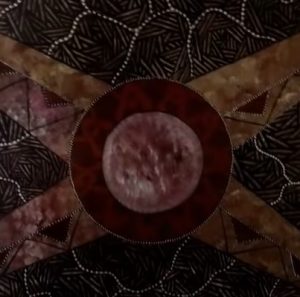
Many of the waterways in northern Victoria enter the Murray River. Enjoy this re-telling of the story as it has been come to be learned by Narjiic Day-Burns.
|
Fern Hames the Fish Lady video
Fern Hames, Murray Darling Basin Authority Native Fish Strategy Co-Ordinator for Victoria, explains that because of the change of river flows, human water usage and the introduction of non-native fish species, there has been a 90% reduction of native fish numbers since the 1860 Burke and Wills expedition passed this area. A short engaging video with some great facts about native fish; Silver Perch and Murray Cod; and introduced fish; Carp and Weather Loaches.
|
Garden Habitats for Small Aussie Birds
This video highlights suitable plants for three groups of small Australian birds; small honeyeaters, small insect-eaters and small seed-eaters. Boosting bird habitat at home, at school, at your River Detectives test site or in your local community is a great project to help our native feathered friends. You may even be able to attract grant funding !
|
Uncle Bryon Powell Interview on the Barwon River, Wadawurrung Country
In this extended interview Uncle Bryon Powell, Wadawurrung Elder and Chair of Wathaurung Aboriginal Corporation, discusses the significance of bark canoes, the impacts of colonisation and the changes to the river landscape for Wadawurrung (Wathaurung) people, and hypothesises what life must have been like for a Wadawurrung man who helped a white domestic servant cross the Barwon River in the 1840s. Please note this is an audio interview, not video. For other cultural/historical videos, documents, photos, etc about waterways near you, type the name of your creek/river into the search bar of the Collection Search tab of the Culture Victoria website. You’ll be amazed at what you find !
|
Rick Nelson Interview at Bet Bet Creek, Dja Dja Wurrung Country
In this extended interview Rick Nelson, Jaara descendant, is interviewed by Lucinda Horrocks on the banks of the Bet Bet Creek, in Eddington, Victoria, part of the traditional land of the Dja Dja Wurrung language peoples. Please note this is an audio interview, not video. Rick talks about how Aboriginal bark canoes were made and what they were used for in the swamps and waterways of Dja Dja Wurrung language country. He talks about the impacts of colonisation and the gold rush on the landscape on the lives of Dja Dja Wurrung people. Lucinda and Rick discuss the life of ‘King Tommy’, an Aboriginal man who lived close by, never far from the Loddon River, in the 19th century. For other cultural/historical videos, documents, photos, etc about waterways near you, type the name of your creek/river into the search bar of the Collection Search tab of the Culture Victoria website. You’ll be amazed at what you find !
|
An introduction to identifying waterbugs with the Waterbug App
This hour-long video was recorded in 2020 for a Melbourne Water webinar series. John Gooderham is a lead expert and creator of the National Waterbug Blitz and the knowledge he shares in this webinar could be very useful for upper secondary students or teachers wishing to improve their identification skills and expertise with the Waterbug App.
|
Waterwise; Innovations In Water Management video
Could Melbourne/Victoria run out of water? In this 43 minute video for secondary students, environmental educator Arron Wood, from Kids Teaching Kids, travels the state to see what’s being done to ensure our water supply in the future and shows just how finely balanced this supply will be. He talks with farmers, town planners, irrigators and park rangers, tours the desalination plant, goes underground at the MCG and learning more about the Werribee sewage treatment plant to see how recycled water is being used for industry and in new housing developments.
|
Waterbug Discovery video
Join Deirdre and Kristen from Corangamite CMA for a great introduction to waterbugs in the Corangamite region. Get to know your regional River Detective staff, how to conduct a sampling session and the creatures you might find. For lower primary students, pause the video to read the text slides aloud. The Now and Then resource referred to is also found on the River Detectives website.
|
Daylesford Water Treatment Plant video
Take a virtual tour of the Daylesford Water Treatment Plant !
|
Catchment to tap video
This video has been produced by Central Highlands Water but the majority of content is relevant to all areas of the state. It features simple explanations of a catchment, the water cycle, how water is shared between users and how water is treated to make it safe in our urban water system.
|
Make a water filter video and experiment
Join Fernando from Barwon Water as he guides students through the process of making a water filter using common household items. This experiment will help students understand how the water cycle provides the water we all need for drinking and how water corporations clean this water for us to drink from our tap. Teacher notes available.
|
Make the water cycle in a bag video and experiment
Join Wally the Water Scientist and Kristy from Goulburn Valley Water to learn how to view the water cycle in a zip lock bag ! A great activity to bring the water cycle to life. Teacher notes provide the blackline masters you need.
|
Make your own rain gauge video and experiment
Join Wally the Water Scientist and Kristy from Goulburn Valley Water to learn how to make a rain gauge and why tracking rainfall is an interesting and informative activity. A great activity to connect maths, science and environmental learning.
|
Water Cycle Meditation no. 2
This guide is useful if you would prefer to step your own class through a water cycle meditation. Teacher notes include a mindfulness colouring sheet and instructions to make a calming jar. Alternatively you can play an audio of the meditation thanks to Barwon Water.
|
Edible aquifer video and experiment
Join Meg Humphrys, author and illustrator of ‘When Water Lost Her Way’ (see Photo/Story Book section of Resource River Bank) for a wonderful edible aquifer experiment students can do to understand groundwater and the water table. Delicious and educational at the same time !
|
Sharing culture across Wadawurrung country video
ABC’s ‘This Place’ project invites Aboriginal and Torres Strait Islander people to create a short video about a place name, and the story behind it. Bryon Powell takes us on a journey across Wadawurrung country, sharing some of the stories behind its place names. His country stretches from the mountains to the sea. It includes hills, rivers and grassy plains, creeks and coasts and includes modern towns such as Werribee, Geelong and Ballarat in Victoria. Search for other videos of cultural stories about waterways across regional Australia at the ABC TV Education website, on ABC iview or at the ABC Indigenous youtube channel.
|
Sharing culture at Barengi Djul (Wimmera River) video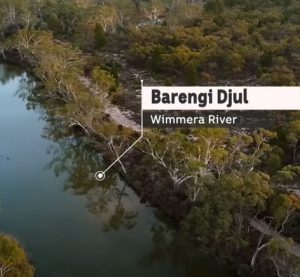
ABC’s ‘This Place’ project invites Aboriginal and Torres Strait Islander people to create a short video about a place name, and the story behind it. The Wimmera River is known as Barengi Djul in Wergaia language spoken by the Wotjobaluk people. Along the water, not far from the township of Dimboola is a special place known as Ackle Bend or Wutiyeti which means camping place, and is also known for its stories of Bunyip. Search for other videos of cultural stories about waterways across regional Australia at the ABC TV Education website, on ABC iview or at the ABC Indigenous youtube channel.
|
Seeing the land from an Aboriginal canoe video
This 10 minute video gives a wonderful insight into the way 19th century European settlers depended on Aboriginal navigators and canoe builders to transport goods, stock and people. This short documentary film explores the little known contribution Aboriginal people made in colonial times across the river systems of Victoria. It features interviews with the historian Associate Professor Fred Cahir and Traditional Owners Uncle Bryon Powell, Jamie Lowe and Rick Nelson. For other cultural/historical videos, documents, photos, etc about waterways near you, type the name of your creek/river into the search bar of the Collection Search tab of the Culture Victoria website. You’ll be amazed at what you find !
|
Waterbugs and water quality video
This 5 minute video from the Envirotube youtube channel explains how waterbugs are important indicators of water quality and habitat diversity and how changes in waterway health can impact them.
|
Introducing waterbugs video
This short 3 minute video by Priya from Melbourne Water is a fabulous tool to introduce waterbugs to your students; what they are, how they live, their wonderful adaptions, why they are so important to the aquatic ecosystem and how they can help us assess water quality and habitat diversity.
|
Make your own window sill pond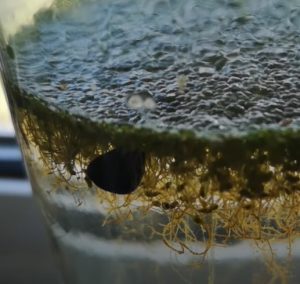
This series of videos takes you on a journey watching the development of a window sill pond over three weeks. Take a look then give it a go with your students ! See how the pond evolves during Week 1, Week 2 and Week 3.
|
How to take great waterbug photos with your device
This video by waterbug guru John Gooderham of The Waterbug Company is full of tips and tricks to take great photos of macroinvertebrates with an iphone when using The Waterbug App for identification. Designed so that photos can be uploaded as part of the National Waterbug Blitz program, this video is just as relevant for River Detectives to study waterbugs and record findings digitally.
|
How beetles breathe under water video
A great video from the Deep Look youtube channel analysing the adaptions beetles have developed to survive and thrive in their aquatic environments. Students will love this peek into the amazing world of water beetles. Check out Deep Look on youtube for other fascinating videos about the lives of terrestrial bugs.
|
Water Striders up close video
A great video from the Deep Look youtube channel analysing the various ways that water striders have evolved to become expert hunters of their aquatic prey. Students will love this peek into the amazing world of water striders. Check out Deep Look on youtube for other fascinating videos about the lives of terrestrial bugs.
|
Water Spider v Water Strider video
A great video from the Monster Bug Wars youtube channel showcasing the unique adaptions of water striders and how they would match up in a battle against a water spider.
|
SBAT with the NCCMA
School Based Apprenticeships and Traineeships (SBAT) are available for high school students over the age of 15 years. Students work for an employer and train towards a recognised qualification while completing their secondary schooling and studying for their VCE or VCAL. The North Central CMA have hosted three students during 2020 helping them build connection to their culture, environmental knowledge and skills, self confidence and career pathways. If you’re an older student looking for inspiration this video shows how SBAT and natural resource management organisations can work together for great outcomes.
|
You And Me, Murrawee picture story book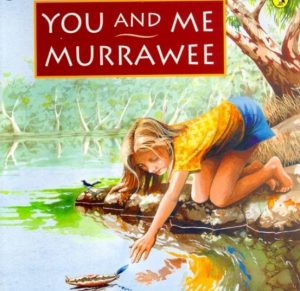
You And Me, Murrawee by Kerri Hashmi is a simple yet very powerful story for primary aged children about the rhythms of daily life beside a river and the many reasons we enjoy time by the water. It highlights the timeless appeal of rivers, the constant yet ever-evolving circle of life for people/plants/animals and prompts us to evaluate modern and traditional life through the subtle revelation that the characters are living 200 years apart. Murrawee means ‘elder sister’ in the language of the Ngarrindjeri people from the Murray River in South Australia but this story is set at an unnamed river and can be used in any location. Enjoy this online reading of the story or purchase the book at your favourite book store. Teacher notes for the story are not available but endless learning opportunities abound.
|
City of Kingston Stormwater Treatment and Reuse Project video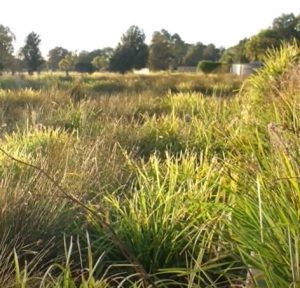
Watch this short video to see how the City of Kingston (Melbourne) are minimising flooding in the low-lying suburb of Edithvale by capturing stormwater, filtering it and reusing it to enhance the suburb. A great example of innovative design helping people and the environment.
|
Stormwater Harvesting at Fitzroy Gardens video
Each year, 120 million litres of water are used to water the Fitzroy Gardens. Since installing a state-of-the-art stormwater harvesting system Melbourne City Council have reduced the use of top quality mains drinking water by 60%. This fantastic video brings diagrams to life showing each step in the process.
|
Innovative Stormwater Solution videos
There are many inspiring programs using innovative inventions and multi-media campaigns to prevent stormwater pollution and raise community awareness of the issue. Check out ‘trash traps’ at the linked title above or any of the following; ‘sea bins‘, ‘drain socks‘, ‘soundscapes‘, ‘litter trackers‘, ‘rain gardens‘ and ‘stormwater stencils‘. Challenge students to do a PMI or venn diagram to compare and contrast each approach.
|
Reusing Stormwater video
It’s estimated that every year Australian cities produce enough stormwater to fill Sydney Harbour six times over, but only 3 per cent of it is reused. Water-sensitive urban design values stormwater as an asset, not a problem. In this 11 minute video hear from experts about changes we can make in our own backyards to increase our water supply and cut down on pollution and flooding. Use the ideas to redesign a house, street or housing estate in your area . . . .
|
Ocean Pollution videos
Regardless of where you are in the state, it is very important for your students to understand how the rubbish they drop could potentially end up in the ocean. The linked title will take you to a short video about the Pacific Ocean garbage dump. Alternatively you can view a 24 minute documentary, “A Plastic Wave” . Many other longer documentaries are available on streaming platforms and get updated regularly. Please be aware that ocean pollution and its impact on sea creatures can introduce disturbing images and information to students – please choose appropriately for different age groups and implement with care.
|
Stormwater Harvesting video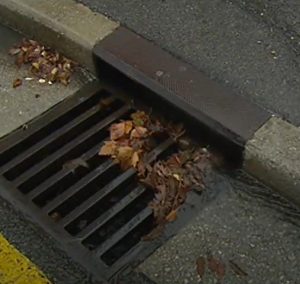
Many Australian towns and cities struggle with drought and desperately try to find new ways to get water. One of the answers might be under our feet! Every year billions of litres of rain flows down gutters and into drains. To change that, councils are being encouraged to recycle stormwater. This old (but still useful) Behind The News video looks at how stormwater harvesting could make better use of water – our most precious resource.
|
Stormwater Pollution – The Dirty Truth: Home Activities video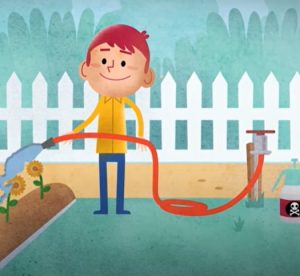
This short animated video from The Dirty Truth website explains how our home activities can impact waterways via urban stormwater discharge; use of pesticides/fertilisers, rinsing paintbrushes, unsecured building materials, oil leaks from cars, litter and dog poo that is not disposed of correctly.
|
Stormwater Pollution – The Dirty Truth: Home Car Washing video
This short animated video from The Dirty Truth website explains the impact of car washing on hard surfaces where detergents can flow down stormwater drains and end up in our waterways.
|
Microplastics in our oceans video
This short video helps students understand how microplastic pollution is generated, how it ends up in oceans and the way it can travel through the food chain to us. It also provides positive ways we can all help to reduce microplastic pollution. Please be aware that content about the potential impact of microplastics on humans may cause anxiety for some students.
|
Microplastics in our streams video
This video takes us on a journey with scientists conducting field research on the microplastics being washed down our waterways. It could provide inspiration to conduct research at your own waterway about the prevalence of these tiny but damaging pieces of pollution . . .
|
Where does stormwater go ? animation
This animated video from Canberra is a highly effective way to outline the chain of events from rainfall, through the stormwater system, to waterways. It uses simple graphics to mathematically represent the volume of water that can be harvested this way and focuses on the many effective strategies that can be put in place by councils, land developers,etc to minimise any negative impacts of urban stormwater.
|
Stormwater animation
This animated video from Dubbo Regional Council is an engaging way to highlight where stormwater comes from, what pollutants might travel into waterways and their impact on water quality and aquatic plants/animals.
|
“The Rhythm of the Rain” picture story book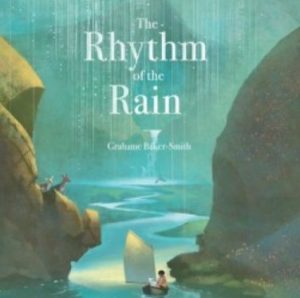
The Rhythm of the Rain by Graham Baker-Smith is a magical book for any educator to launch a lesson or a unit on the water cycle, on the geography of our planet, on the diversity on our planet…there are so many themes hidden within. This story will stretch students’ imaginations, their curiosity, their appreciation of the amazing natural world that surrounds us and nourishes us. Thanks to Alice from Coliban Water in the north central region you can watch a reading of the book as a springboard to other discussions and activities around the water cycle, catchments and the responsibility we all share around the world to conserve water for everyone. Use the links above and below this post to access your local water authority and get involved in their education resources and incursions.
|
“Water is Water” picture story book
Water is Water by Miranda Paul is a lovely book for lower primary exploring the water cycle, the ways we experience water in all it’s forms; rain, steam, fog, frost, snow, puddles; and how we use water for fun, gardening, drinking, etc. Thanks to Alice from Coliban Water in the north central region you can watch a reading of the book as a springboard to other discussions and activities around water. Use the links above and below this post to access your local water authority and get involved in their education resources and incursions.
|
Water Cycle Meditation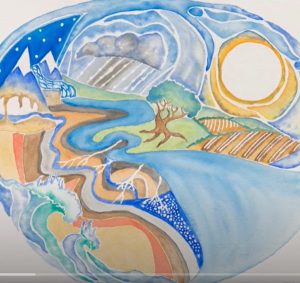
A meditation for kids and grown ups that takes you on a journey through the water cycle. Content is loosely based on the picture story book ‘When Water Lost Her Way’ written and illustrated by Meg Humphrys.
|
“When Water Lost Her Way” picture story book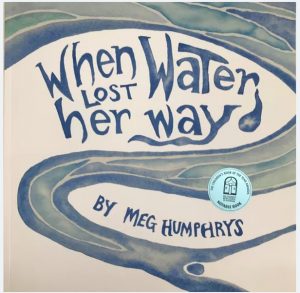
This is a powerful story by Meg Humphrys of ‘water’ questioning who she is. She seeks all parts of her cycle for answers until an ‘old tree’ helps her to understand her place in the world and her many interconnections with all living and non-living things. This book is a must-have in the school library, however you can enjoy the online reading or read the digital version yourself. Indulge in water cycle meditation, discuss extension questions or explore enquiry based lesson plans based on the story. During National Water Week 2020, Meg was interviewed and the video is a great way to further children’s engagement with this book and the water cycle (they’ll love the edible aquifer idea!) Meg has gone on to write a second book called “Wave Of Change” to explore the impact of climate change on our water resources. Search for Wave of Change in the Resource River Bank tab.
|
“Where’s Our Water” digital picture story book
This book came out of a project co-ordinated by Hunter Water in NSW. Although it is not local, the story has valuable messages that apply to any catchment and the project is an inspiring example of what can be achieved when students work closely with traditional owners. Where’s Our Water? has been written for primary school students in the Lower Hunter region to teach them about the value of water as a precious resource and that it is everyone’s responsibility to care for it to ensure we have enough now and into the future. Hunter Water has collaborated with both the Awabakal and Worimi communities to create this new story that draws on their traditional wisdom and practices of caring for our land and waterways. You can also watch a video about the project.
|
The Wimmera’s Flowing Tale video
Take a journey along the depth and breadth of the Wimmera River catchment. Produced in 2006, this short film is a fantastic look back at our river system. It focusses on how Wimmera CMA looks after the catchment and how they manage environmental water releases. Although many things have changed since this film was made, such as completion of the Wimmera Mallee Pipeline and more security for environmental water releases, the themes in this flowing tale have stayed the same.
|
Bendigo Creek Citizen Science Project student presentation videos
The Reimagining Bendigo Creek aims to create a healthier, more inclusive, connected and beautiful Creek that we can all respect and value. After attending a workshop in 2019 about the assets and threats of Bendigo Creek, students were challenged to present their vision for a future Bendigo Creek and their innovative results were amazing ! View Huntly Primary School’s creative lego model presentation at the title link above and Epsom Primary School’s engaging video here as inspiration for your own student-led waterway championing project.
|
Surveying Gurru (Lake Hindmarsh)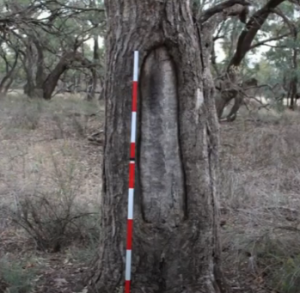
This documentary was created as part of National Reconciliation Week 2016 by Barengi Gadjin Land Council and Cooper Heritage Management to highlight cultural heritage survey activities on the iconic Lake Hindmarsh in western Victoria. Their findings help us understand how the area was traditionally used and the importance of Lake Hindmarsh in the past, present and future.
|
Wimmera Water Short Stories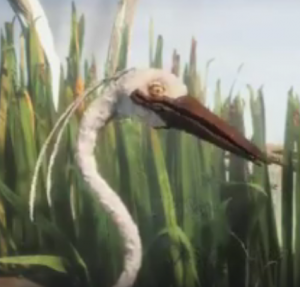
Our waterways are very special and mean something to each of us. In this series of three short stories the Wimmera CMA have been innovative and put the voices and stories of people in their region to the animated characters of the Fresh and Salty film. In Story 1 at the title link above, a tree (farmer) talks about his family being a guardian to the river over many generations. In Story 2 members of the community appear as a mosquito, fish and mollusc to tell how it feels to waterski on the river or sit beside it. In Story 3 an egret and fish share what the river means to the young and old.
|
Wimmera River at Jeparit flows into Lake Hindmarsh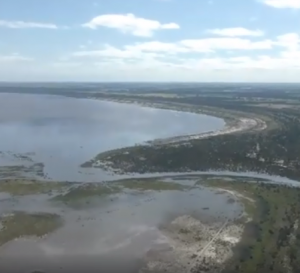
In September 2016 the Wimmera region enjoyed seeing many of their waterways flowing and lakes filling! The CMA filmed the breathtaking sight of Lake Hindmarsh from the air with the majority of the lake’s 139 square km surface area covered by water. Lake Hindmarsh is Victoria’s largest freshwater lake. Previously it filled after the 2011 floods but since then had been dry. It is a popular spot for camping, birdwatching, sailing and brings visitors from around the world. The lake also supports a diverse array of plants and animals including birds, frogs, fish and river redgums.
|
Waterways for life – healthy rivers, healthy communities
The Wimmera River in Western Victoria is where many people start or end their days, socialise, gather and be part of community events.
In this story by the Wimmera CMA join marathon swimmer Tammy Van Wisse and Wimmera locals to see just how much people rely on healthy waterways for their own physical and mental health. Healthy rivers also keep communities vibrant and alive by bringing everyone together – whether it’s for a walk, a run, a paddle, special event, fishing or just a picnic.
|
Finding Hope – Wimmera Platypus Surveys
The Wimmera CMA take you behind the scenes of their MacKenzie River platypus surveys in the Grampians. This footage was filmed during their 2019 autumn surveys. In the spring of that year they returned and filmed more beautiful footage of a male platypus.
|
World Wetlands Day – A Wimmera Wetland video
To celebrate World Wetlands Day 2020 the Wimmera CMA zoomed in on Dock Lake near Horsham that received water for the first time in two decades in 2016. They recorded the great diversity and abundance of waterbirds that flocked to the lake, showing how adding water to wetlands can trigger a huge response from nature.
|
The Wimmera – A Flowing Fish Tale video
This video produced by Wimmera CMA is a great example for all regions of how a healthy river that strikes the balance between the needs of plants, animals and people can build a vibrant community. It shows that strategies ensuring healthy fish populations boosts the enjoyment of the river by local and visiting anglers and sends the message that if you look after the river, it will look after you.
|
Restoring salt affected land video
West Australian farmers Tim and Val Saggers have been restoring salt affected land on their farm for more than a decade, using native perennial shrubs and grasses. Although native perennial pastures are not yet a popular option in WA compared to the eastern states, the Saggers’ have not been deterred and have managed to reclaim once unproductive land and made their farm more productive and sustainable for future use. Although not a local example, this video follows principles that are effective in any salt-ravaged environment.
|
Mooroobull Yaluk Kuwin River Day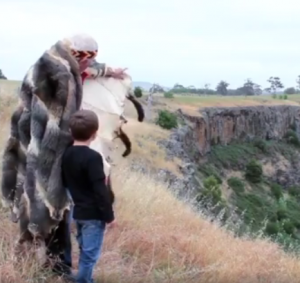
In February 2018 the Corangamite CMA and Wathaurung Aboriginal Corporation hosted a community fishing day with the Wadawurrung community on the Moorabool River.
|
Celebrating Water and Culture on The Mooroobull Yaluk
Corangamite CMA worked with the Wadawurrung Traditional Owners in developing a joint bid for additional water for the Moorabool River. This was to protect the environmental and Aboriginal values within the rivers on Wadawurrung Country. The bid was successful and an additional 500 megalitres was released down the river when it was most needed. This allowed the Wadawaurrung community to come together, practice cultural values and share their knowledge.
|
Making Every Drop Count video
When Ian Campbell and Dr Sue Swaney bought their Deans Marsh farm in 1988, the landscape had only seven trees and a large erosion gully that nearly split the property in half. The transformation they’ve achieved in just three decades is astounding. In recent years the Corangamite CMA’s On-Farm Water Efficiency Project has supported Ian and Sue to design and manage a state-of-the-art farm water supply system to improve outcomes for animal health, catchment health and biodiversity. This is a great example for any region of the responsibility that all landowners in a catchment have toward waterway health.
|
Barwon River Planting Day video
Over 40 local recreational anglers braved wet and windy conditions in July 2019 to help revegetate the Barwon River. Thousands of native trees, shrubs and grasses were planted on the banks of the lower Barwon River near Marshall, south of Geelong, to return a one kilometre stretch of the river to its original woodland habitat. This is a great example of working together to improve fish habitat.
|
‘Birds in Backyards’ seasonal bird survey program
Get involved in seasonal bird surveys with Birdata, Birdlife Australia’s easy-to-use website and app. Both resources automatically give you a list of 30 birds from your region to help get you started – so you don’t need to be an expert to take part. Use this video to learn how to get started using the Birdata website to enter your results or, if you are a maths maniac, browse, filter, graph, analyse and compare bird data from anywhere in Australia. The App is a portable conservation tool allowing volunteers to leap into the colourful world of birdwatching and enter bird survey data via phones or tablets. You can also get involved in the Aussie Backyard Bird Count in October each year, a nationwide citizen-science event.
|
Catchments – the sponge effect video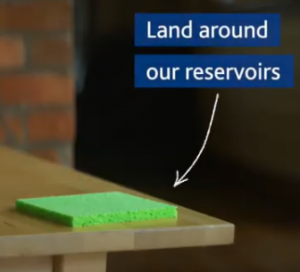
Only around 30% to 50% of the rain that falls on our catchments each year ends up in waterways. For example, only about 10% of rainfall during summer turns into runoff because the dry soil acts like a sponge, soaking up the rain before it can flow into streams. Watch this video to see how this changes from season to season depending on how wet the soil in the catchment is.
|
Melbourne’s drinking water video
Learn why Melbourne’s water tastes great straight from the tap !
|
Woodend PS planting day video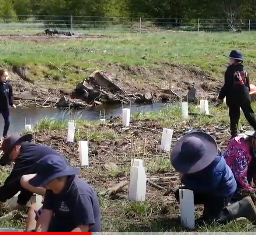
In October 2019, the NCCMA worked with Coliban Water and Dja Dja Wurrung to hold a planting day on the banks of the Campaspe River with Grade 4 students from Woodend Primary School. Students helped to plant some of the 20,000 native trees and shrubs, and learned about the positive impact the plants and fencing will have on water quality and catchment health.
|
River Detectives involved in river health video
This video explains how River Detectives schools can be integrally involved in river health projects when they partner with NCCMA projects and local Landcare groups. See examples of how Woodend and Goornong primary schools enjoy participating.
|
Enhancing Dandenong Creek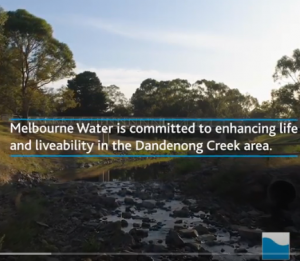
Melbourne Water’s ‘Enhancing Our Dandenong Creek’ project is taking an innovative approach to sewerage management and bringing the creek back to life. Although Melbourne based, this is a great case study to show students how urban water can be managed effectively. For more information go to Melbourne Water’s website
|
Birth of the Brolga
Rare footage of a pair of brolga incubating and rearing two chicks highlights the need for a plan to deliver environmental water to wetlands.
|
Frogs at McDonalds Swamp and Wirra-Lo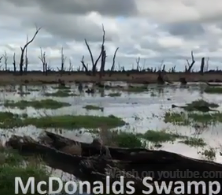
Delight at the sound of the frog chorus in two of north central Victoria’s wetlands.
|
Aunty Esther’s Story of Change
Traditional Owner Aunty Esther tells the story of the Barapa Barapa connection to Gunbower Forest.
|
Cohuna Fish Screens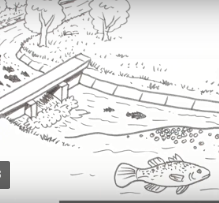
This engaging animation clearly explains the problems that irrigation channels can cause for native fish and how fish screens are proving to be an effective solution.
|
Gunbower Forest bird breeding event video
This short video shows how environmental watering programs can make a difference to the health and reproduction of water birds.
|
Barapa Wamba Water for Country River Tour 2019 video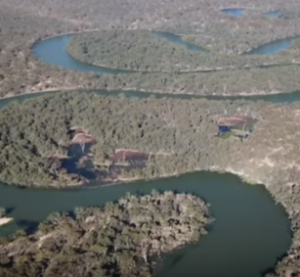
This video showcases an innovative NCCMA event for traditional owners to come together with land managers to spend time on country, learn from each other and allow time together on the river to strengthen relationships.
|
The Waterwatch Story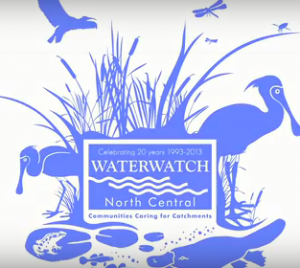
The North Central Waterwatch Program aims to increase the knowledge and skills of community, supporting them to become custodians of local waterways. River Detectives is the school/youth based component of the program. This video will help your students understand the community of passionate people that they belong to by being a River Detective.
|
Toxic Blackwater Explained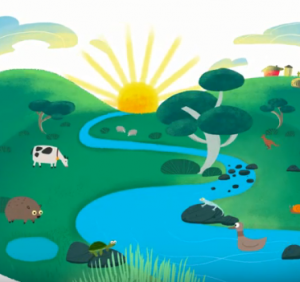
This video provides a simple explanation of the causes and effects of blackwater. And to learn how environmental water releases can help minimise the impacts of blackwater watch this video.
|
Water for the Environment; it’s all about timing
As well as the water in a river that naturally falls from rain, river and wetland flows are actively managed to maintain or improve their health and with the aim of achieving key ecological objectives such as:
This short video is an engaging animation that explains the issue simply.
|
Environmental Water and the Community video
The Loddon Murray Wetlands consist of one actively managed private wetland complex and 13 public-land wetlands located on the Murray and Loddon River floodplains. The wetlands are of international and/or regional significance and collectively cover an area of more than 2,800 hectares. This video highlights the importance of environmental watering to return natural watering cycles to waterways and wetlands in the north central region.
|
Lower Campaspe Flyover video
This 9 minute video shows edited footage of a drone journey along the Campaspe River from Axedale (just downstream of Lake Eppalock) to Echuca. Set to peaceful music it is a relaxing way to soar like an eagle over the waterway and start conversations about land practices along the way and strategies to balance river health with productive community life and agriculture.
|
3 Rivers Flow Indigenous Hip Hop project video
Be inspired by this awesome video of Yorta Yorta children leading their mob in a song about their country defined by three rivers; the Campaspe, the Goulburn and the mighty Murray River. Maybe you could do a similar project with your students to tell (or sing) a story about your local waterway ?
|
Caring For The Campaspe project video
The Caring for the Campaspe project is the first large scale on-ground works project to deliver river health improvements for the Campaspe River from its headwaters near Ashbourne to the Murray River at Echuca. Since 2012, the North Central CMA has been providing fencing, offstream watering, weed control and revegetation incentives to interested land managers on both public and privately owned along the river’s length. This video is a great example of the great outcomes that can be achieved when passionate groups work together to improve river health.
|
Traditional Owner Campaspe River Tour video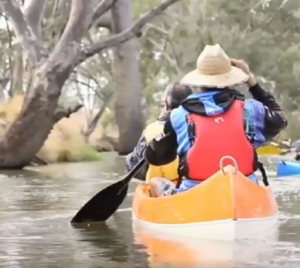
The NCCMA’s Caring for the Campaspe River project means more than just ensuring environmental values are protected and enhanced. The river has a rich cultural history and spending time there is a meaningful way for our Traditional Owners to connect with country and go on a journey of mutual learning with land managers.
|
Murray Darling Basin video
This quirky 12 minute video provides an excellent explanation of how catchments work and the animals, plants, communities and livelihoods that depend on them being well managed. It highlights the importance of balancing the needs of the environment and humans. All waterways North Central, Wimmera and North East CMA regions are part of the southern most section of the Murray Darling Basin.
|
How Wolves Change Rivers video
When wolves were reintroduced to Yellowstone National Park in the United States after being absent nearly 70 years, the most remarkable changes occurred. Although this is an American example, this video is a powerful example of how everything in nature is inextricably linked and one change can cause a ripple effect, in this case called a ‘trophic cascade’.
|
How to run a waterbug session video
In this video Priya from Melbourne Water takes you through the key steps of how to sample and study macroinvertebrates (waterbugs). Don’t forget to contact your local Catchment Management Authority to arrange a loan of macroinvertebrate equipment to run a sampling activity with your students or set up your school’s own kit.
|
ResourceSmart Schools program
The ResourceSmart Schools and River Detectives programs work well side by side helping you achieve parts of the Water, Biodiversity and Waste modules ! Watch this webinar to learn about how the River Detectives program can help schools achieve water, biodiversity and waste actions so the two programs can work smarter, not harder! All program links are documented here. And check out how River Detectives schools fared at the 2024 ResourceSmart Schools awards!
|
Nine days on Tang Tang Swamp
A beautiful and breathtaking secret insight into life on a drying waterhole at a public wetland located in north central Victoria
|
Fresh and Salty video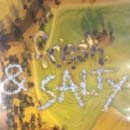
Fresh and Salty is a highly engaging short animated film produced by the Wimmera CMA. It is the perfect way to introduce the topic of salinity to your students
|

